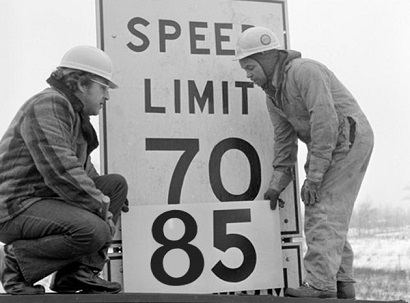Florida Considering Speed Limit Increase: Reward for Responsible Citizenship?
 As any regular reader of my blog knows, I find speeding tickets particularly egregious. Speed traps, ticket quotas, those sneaky cops that hide behind bushes – they are part of the State of Florida’s traffic ticket grist mill that continues to spew out huge profits for the state. So many times, we are confined to certain speed limits in areas where they don’t make any sense. You are on an open road with no one around and the speed limit is 45 mph. There are very few intersections and traffic is sparse, yet behind the one obstacle off to the side of the road sits a cop with a radar gun. We have all experienced driving down a road where the imposed speed limit just seems ludicrous for the area. There is very little to impede progress on some roads, so why not go faster? What about those businesses through town that the city seems to think warrant a 20 mph speed zone and a traffic signal every 25 feet? It is so frustrating.
As any regular reader of my blog knows, I find speeding tickets particularly egregious. Speed traps, ticket quotas, those sneaky cops that hide behind bushes – they are part of the State of Florida’s traffic ticket grist mill that continues to spew out huge profits for the state. So many times, we are confined to certain speed limits in areas where they don’t make any sense. You are on an open road with no one around and the speed limit is 45 mph. There are very few intersections and traffic is sparse, yet behind the one obstacle off to the side of the road sits a cop with a radar gun. We have all experienced driving down a road where the imposed speed limit just seems ludicrous for the area. There is very little to impede progress on some roads, so why not go faster? What about those businesses through town that the city seems to think warrant a 20 mph speed zone and a traffic signal every 25 feet? It is so frustrating.
Well, the good news, at least for Florida highways like I-95, it that Florida legislators are considering raising the speed limit to 75 mph. This is, in fact, great news for those of us who travel these highways regularly and just want to get to where we are going, but we do need to stop and ask ourselves a couple of questions.
- Will an increase to 75 mph help reduce the number of tickets issued or will people just drive that much faster?
- Will we see an increase in the penalties for speeding tickets, such as stiffer fines or more points against our licenses, if ticketed for going above the proposed speed limit increase?
Consider the first question. The current speed limit is 65 mph and most drivers travel at 70 – 75 mph. It is hard to predict whether or not drivers would then travel at 80 mph or more thinking, “Its only five miles per hour more.” Although increasing the speed limit is a popular idea with a lot of drivers, there are just as many critics of imposing higher speed limits. Not only are those in opposition to an increase concerned about road safety, it has also been suggested that better roads, safety restraints, and other safety controls in newer cars create a false sense of security for drivers. Consequently, it is conceivable that “just five miles per hour more” could possibly spur legislators into increasing fines for a lesser infraction of speeding violations.
While raising speed limits in all areas is not necessarily the best option, generally, I think that raising the speed limit on highways is a good thing. Our interstates were designed to help traffic move along freely and, barring some guy going 40 mph in the passing lane at 5 p.m., raising the speed limit would help ease the flow of traffic.
There are no easy answers when it comes to setting speed limits. I tend to agree with the National Motorists Association’s stance that speed limits need to be determined by the principle that responsible motorists travel at safe speeds, even when that speed may not be the posted speed limit. The NMA states that a safe speed limit is the speed under which 85% of traffic is traveling. These speed limits may need to be adjusted periodically dependent upon changing road conditions, population growth, and so forth, but it is a rational guideline for setting speed limits. This theory was reaffirmed by a 2013 study conducted by AAA which showed that in many areas of Washington D.C. fines had been cut and the number of speeding tickets decreased in direct correlation with the increase of speed limits.
Another benefit to raising speed limits is a reduction in road rage or aggressive driving. Such was the case when the state of Michigan raised the speed limit on one section of I-496 from 55 mph to 70 mph. Incidents of tailgating, passing, and speeding all declined; the number of accidents was also reduced; and traffic flow was greatly improved due to the speed limit increase.
The jury is still out on whether or not increasing or decreasing speed limits make our highways safer. Since 1996 when the speed limit was last increased, there is data that indicates that fatalities are down, but there are so many mitigating factors to consider that it makes it difficult to determine the hard facts. Population increases and a rise in longevity would both indicate that there are more drivers on the roads; the greater number of drivers, the greater the likelihood of accidents. Yet, with better engineering of roadways and safer cars, the “hard” data becomes fluid. Additionally, this trend has been occurring for 50 years. In the early part of the 20th century, Americans took to the roads in droves. During that time frame, there were about 25 casualties per year among drivers for every 100,000,000 miles they traveled. If we applied the same ratio to the number of drivers today versus the number of miles traveled, we would have approximately 700,000 deaths per year. Yet in 2012, there were less than 26,000 vehicle fatalities in the U.S.
A major factor in the disparity between the fatalities per miles driven is the improvement of both roads and cars. There are innumerable safety features on cars today that would never have occurred to car manufacturers of previous eras. Anti-lock brakes, steel-belted tires, seat belts, and air bags are just a few of the features that have led to huge reductions in traffic fatalities. Because there are so many safety features on our vehicles today, there is little mechanical comparison to vehicles of 50 or more years ago.
Another major contributing factor to the decline of casualties is our improved roadway system. Prior to 1940, most roads were only two lanes, one for each direction of travel. If you wanted to get around someone in front of you, your options were to drive off the right side of the road or drive into the oncoming lane to get in front of him. Needless to say, this led to a lot of head-on collisions. Today, not only do we have 4-, 6-, 8-, and 10-lane highways with barriers between the opposite lanes of travel, but we have an entire highway department which was created for the primary purpose of engineering safe roads and maintaining those same roads. This maintenance includes pot-hole repairs, widening of roads to accommodate increased traffic, and even clean-up to help drivers avoid debris from accidents, road kill, etc.
The variables regarding why there has been a decline in fatalities can be discussed ad infinitum, but I think that speed limits are often wrongly assigned and enforced for no better reason than to keep that grist mill grinding. Florida citizens are fined billions of dollars each year which maintains a steady stream of income under the guise of trying to keep us safer. These actions negate the simple concept that the NMA puts forth that most drivers are responsible. Sure, we all get traffic tickets, but they are seldom the result of blatant abuse of traffic laws. The decrease in death rates has nothing to do with the speed limits that are imposed. We all need to encourage our legislators to remember that most of us are responsible citizens when it comes to driving, and they should set speed limits accordingly.

FREE CONSULTATION
866-433-3363
Call now or contact us for a fast, free, no obligation consultation.

